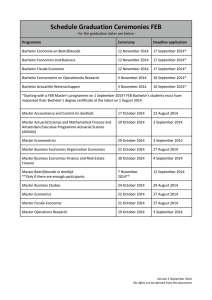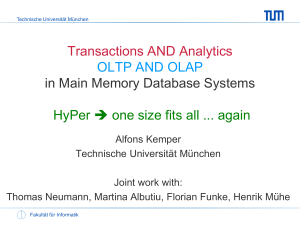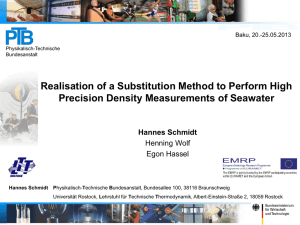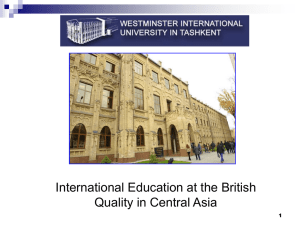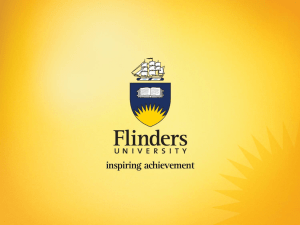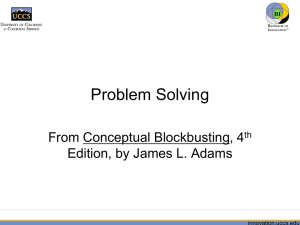Foil Slides - Technische Universität Braunschweig
advertisement
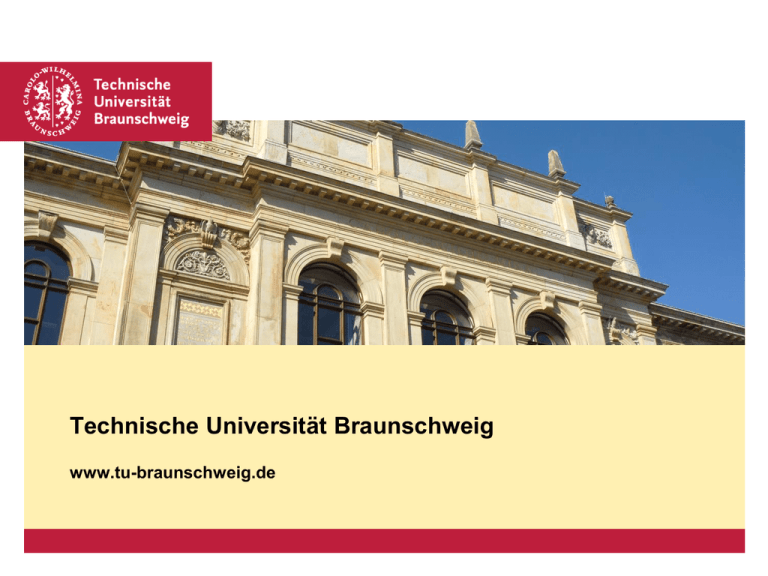
Technische Universität Braunschweig www.tu-braunschweig.de Technische Universität Braunschweig 1 university 6 departments 71 degree programmes 120 institutes 2,089 scientists 3,651 university employees 4,730 first semester students 18,474 78,900,000 298,000,000 students (full-time) (each year) (Winter semester 2014/2015) euros in outside funding euros in overall budget Figures 2013 Technische Universität Braunschweig – 2 History 1745 The Collegium Carolinum, a new type of educational institution between secondary school and university, is established. 1878 The institute is renamed Ducal Polytechnic School (Herzogliche Technische Hochschule Carolo-Wilhelmina). 1968 After the establishment of a Faculty of Humanities and Social Sciences, the TH is renamed Technische Universität. 1978 The Teacher Training College is incorporated into TU Braunschweig. Technische Universität Braunschweig – 3 History 2006 Creation of TU9, an association of the nine leading German universities of technology. 2007 Braunschweig is named »City of Science 2007«. 2007 Foundation of the Automotive Research Centre Niedersachsen (NFF). 2009 Foundation of the Aeronautics Research Centre Niedersachsen. 2009 Foundation of the Braunschweig Integrated Centre of Systems Biology. 2011 Foundation of the Centre for Pharmaceutical Process Engineering. 2012 Funding authorised to create the Open Hybrid LabFactory Research Campus. 2013 Foundation of the Research Centre for Nanometrology. Technische Universität Braunschweig – 4 Good reasons for choosing TU Braunschweig An excellent reputation and a long tradition – since 1745 The university with the broadest range of engineering courses in Northern Germany Top-notch connections in Europe’s number one research region Jobs and research projects at local research institutes and companies First-rate contacts with the industry and hands-on training Short distances between the TU’s campuses in the vibrant city of Braunschweig Technische Universität Braunschweig – 5 6 Departments Carl-Friedrich Gauß: Mathematics, Computer Science, Business Science and Social Sciences Life Sciences Architecture, Civil Engineering and Environmental Sciences Mechanical Engineering Electrical Engineering, Information Technology and Physics Humanities and Educational Sciences Technische Universität Braunschweig – 6 Carolo-Wilhelmina Research Centres MOBILITY Automotive Research Centre Niedersachsen (NFF) Open Hybrid LabFactory Aeronautics Research Centre Niedersachsen (NFL) INFECTIONS AND ACTIVE AGENTS Braunschweig Integrated Centre of Systems Biology (BRICS) Centre for Pharmaceutical Process Engineering (PVZ) NANOMETROLOGY Laboratory for Emerging Nanometrology and Analytics (LENA) Technische Universität Braunschweig – 7 Student enrolment numbers Technische Universität Braunschweig – 8 Mathematics, Computer Science, Business Science, Social Sciences Degree Programmes Business Informatics (Bachelor, Master) Computer Science (Bachelor, Master) Integrated Social Sciences (Bachelor) Internet Technologies and Information Systems (Master) Mathematics (Bachelor, Master) Mathematics in Finance and Industry (Bachelor, Master) Media Sciences (Bachelor) Media Technology and Communication (Master) Organization, Governance, Education (Master) Personal Development in Business (Certificate) Technology-orientated Management (Master) Technische Universität Braunschweig – 9 Life Sciences Degree Programmes Biology (Bachelor, Master) Biotechnology (Bachelor, Master) Chemical Biology (Master) Chemistry (Bachelor, Master) Child and Adolescent Psychotherapy Food Chemistry (Staatsexamen) Pharmacy (Staatsexamen) Psychology (Bachelor, Master) Psychotherapy (Approbation) Technische Universität Braunschweig – 10 Architecture, Civil Engineering and Environmental Sciences Degree Programmes Architecture (Bachelor, Master) Architecture+ (Bachelor) Civil Engineering (Bachelor, Master) Computational Sciences in Engineering (Master) Environmental Engineering (Bachelor, Master) European Master in Territorial Development (Master) Geoecology (Bachelor, Master) Industrial and Civil Engineering (Bachelor, Master) Mobility and Transportation (Bachelor, Master) ProWater (Master) Sustainable Design (Master) Technische Universität Braunschweig – 11 Mechanical Engineering Degree Programmes Aerospace Engineering (Master) Automotive Engineering (Master) Biological, Chemical and Pharmaceutical Engineering (Bachelor) Biological and Chemical Engineering (Master) Industrial and Mechanical Engineering (Bachelor, Master) Mechanical Engineering (Bachelor, Master) Metrology and Analytics (Master) Pharmaceutical Engineering (Master) Technische Universität Braunschweig – 12 Electrical Engineering, Information Technology and Physics Degree Programmes Computer Systems Technology (Bachelor, Master) Electrical Engineering (Bachelor, Master) Electromobility (Master) Electronic Vehicle and Aerospace Systems (Master) Industrial and Electrical Engineering (Bachelor, Master) Physics (Bachelor, Master) Technische Universität Braunschweig – 13 Humanities and Educational Sciences Degree Programmes 2-subject Bachelor’s degree (B.A. or B.Sc.) Culture of the Technical-Scientific World (Master) Educational Sciences (Bachelor) Teacher Training Course – Grund- und Hauptschule (Master) Teacher Training Course – Realschule (Master) Teacher Training Course – Gymnasium (Master) Technische Universität Braunschweig – 14 International 2,356 international students from more than 100 countries study at TU Braunschweig They make up 13 per cent of the student body. Top-notch connections: 300 partner universities around the world 250 cooperation programmes with European universities (Erasmus) Key exchange partners: Europe, USA, Canada, South America, China and Japan Technische Universität Braunschweig – 15 Europe’s Number 1 Research Region 4 higher education institutions TU Braunschweig, Hochschule für Bildende Künste Braunschweig, Ostfalia Hochschule für Angewandte Wissenschaften, TU Clausthal 18 non-academic research institutes 9 of which are either federal research facilities or federal offices: Deutsches Zentrum für Luft- und Raumfahrt (DLR), Fraunhofer-Institut für Holzforschung – Wilhelm-Klauditz-Institut (WKI), Fraunhofer-Institut für Schicht- und Oberflächentechnik (IST), Georg-Eckert-Institut für Internationale Schulbuchforschung (GEI), Helmholtz-Zentrum für Infektionsforschung (HZI), Johann Heinrich von Thünen-Institut (vTI), Julius Kühn-Institut (JKI), Luftfahrtbundesamt, Physikalisch-Technische Bundesanstalt (PTB) 7 cultural and cultural dissemination institutes i.a. Herzog Anton Ulrich-Museum, Herzog August Bibliothek, phæno Science-Center More than 50 companies with research departments i.a. Volkswagen AG, Siemens AG, Salzgitter AG Technische Universität Braunschweig – 16 Europe’s Number 1 Research Region Braunschweig is Europe’s most active research region Braunschweig is the top region for innovation with the highest level of research and development expenditures in Europe (Eurostat, 2011). Braunschweig is ranked first in the nation for the number of inhabitants working in science (Zukunftsatlas, 2010). Number 1 in Lower Saxony Number 2 in Northern Germany Number 8 in the list of Germany’s most dynamic cities (annual comparison of the 50 largest cities in Germany) Technische Universität Braunschweig – 17 The City of Braunschweig – university and life style a population of roughly 250,000 a rich historical past, exciting present and high-tech focused future both historically and presently, the heart of the region a dynamic location for trade and economy vibrant cultural life an exceptional research and science landscape Technische Universität Braunschweig – 18
